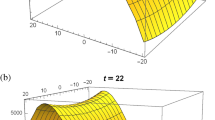Abstract
This article deals with closed form solutions associated with Zoomeron equation (ZME) in \((2+1)\)-dimensions. These solutions are obtained by similarity transformations method involving Lie group theory. The symmetry reduction of ZME for different vector fields are deduced from the invariant condition of the primary equation. Next, the group invariant solutions in their explicit form are derived with the help of corresponding symmetry reductions. Initially, the partial differential equation (PDE) that consists of lesser independent variables than the primary ZME are obtained. And then, the obtained PDE is changed to new ordinary differential equation (ODE) using similarity transformations and this ODE gives the closed form of solutions for the considered ZME by back substitution. The final outcomes display that the involved methodology is quite reliable, productive and easy to solve these kinds of equations in mechanical sciences, nonlinear optics and mathematical physics.


Similar content being viewed by others
Data Availability
There are no additional data and materials involved.
References
Russell, J. S.: Report on Waves Report of the Fourteenth Meeting of the British Association for the Advancement of Science (New York: London) 311-90 Plates XLVII-LVII (1844)
Calogero, F., Degasperis, A.: Spectral transform and solitons I, Studies Math. App., 13, (1982)
Aksoy, E., Çevikel, A.C., Bekir, A.: Soliton solutions of (2+ 1)-dimensional time-fractional Zoomeron equation. Optik 127(17), 6933–6942 (2016)
Tala-Tebue, E., Djoufack, Z.I., Djimeli-Tsajio, A., Kenfack-Jiotsa, A.: Solitons and other solutions of the nonlinear fractional Zoomeron equation. Chinese J. Phys. 56(3), 1232–1246 (2018)
Abdul Kayum, Md., Ali Akbar, M., Osman, M.S.: Stable soliton solutions to the shallow water waves and ion-acoustic waves in a plasma. Waves Ran. Comp. Med. 32(4), 1672–1693 (2022)
Hosseini, K., Mirzazadeh, M., Salahshour, S., Baleanu, D., Zafar, A.: Specific wave structures of a fifth-order nonlinear water wave equation. J. Ocean Eng. Sci. 7(5), 462–466 (2021)
N’Gbo, N., Xia, Y.: Traveling wave solution of bad and good modified boussinesq equations with conformable fractional-order derivative. Qual. Theory Dyn. Syst. 21, 1–21 (2022)
Higazy, M., Muhammad, S., Al-Ghamdi, A., Khater, M.M.: Computational wave solutions of some nonlinear evolution equations. J. Ocean Eng, Sci (2022)
Sil, S., Guha, P.: Symmetry reductions and exact solutions of two new generalized negative KdV type equations. J. Geo. Phys. 178, 104558 (2022)
Sil, S., Sekhar, T.R.: Nonlocal conservation laws and dynamics of soliton solutions of (2 + 1)-dimensional Boiti–Leon–Pempinelli system. Phys. Fluids 34(11), 117113 (2022)
Yang, D.Y., Tian, B., Shen, Y., Gao, X.T.: Solitons, breathers and modulation instability for a higher-order coupled nonlinear schrodinger system for the ultrashort optical pulses in a nonlinear medium. Qual. Theory Dyn. Syst. 22(2), 59 (2023)
Sil, S.: Nonclassical symmetries, nonlinear self-adjointness, conservation laws and some new exact solutions of cylindrical KdV equation. Int. J. Appl. Comp. Math. 9(5), 69 (2023)
Sil, S., Sekhar, T.R.: Nonclassical potential symmetry analysis and exact solutions for a thin film model of a perfectly soluble anti-surfactant solution. Appl. Math. Comp. 440, 127660 (2023)
He, J.-H., Wu, X.-H.: Exp-function method for nonlinear wave equations. Chaos Sol. Frac. 30(3), 700–708 (2006)
Liu, S., et al.: Jacobi elliptic function expansion method and periodic wave solutions of nonlinear wave equations. Phys. Lett. A 289(1–2), 69–74 (2001)
Ablowitz, M.J., Segur, H.: Solitons and the Inverse Scattering Transform. SIAM, Philadelphia (1981)
Miura, M.R.: Bäcklund Transformation. Springer, Berlin, Germany (1978)
Wang, M., Li, X., Zhang, J.: The \((\frac{G^{\prime }}{G})\)-expansion method and travelling wave solutions of nonlinear evolution equations in mathematical physics. Phys. Lett. A 372(4), 417–423 (2008)
Chetteti, R., Srivastav, A.: The second law analysis in free convective flow of pseudoplastic and dilatant fluids over a truncated cone with viscous dissipation: Forchheimer model. J. Thermal Ana. Cal. 147(8), 5211–5224 (2022)
Chetteti, R., Srivastav, A.: Efficient spectral method for stable stratified power-law fluid flows with dispersion over convectively heated truncated cone in a non-Darcy porous medium. Int. J. App. Comp. Math. 7, 1–17 (2021)
Bluman, G.W., Cole, J.D.: Similarity Methods for Differential Equations. Springer, New York (1974)
Bogoyavlenskij, O.: Restricted Lie point symmetries and reductions for ideal magnetohydrodynamics equilibria. J. Eng. Math. 66(1–3), 141–152 (2010)
Hirota, R.: The Direct Method in Soliton Theory. Cambridge University Press, New York (2004)
Fan, E.: Extended tanh-function method and its applications to nonlinear equations. Phys. Lett. A 277(4–5), 212–218 (2000)
Bluman, G.W., Kumei, S.: Symmetries and Differential Equations, vol. 81. Springer Science & Business Media, New York (1989)
Olver, P.J.: Applications of Lie Groups to Differential Equations, second edition, Graduate Texts in Mathematics, vol. 107. Springer, New York (1993)
Jadaun, V., Kumar, S.: Lie symmetry analysis and invariant solutions of (3+1)-dimensional Calogero-Bogoyavlenskii-Schiff equation. Nonlinear Dyn. 93(2), 349–360 (2018)
Jadaun, V., Kumar, S.: Symmetry analysis and invariant solutions of (3+1)-dimensional Kadomtsev–Petviashvili equation. Int. J. Geom. Method Mod. Phys. 15(8), 1850125 (2018)
Funding
The authors did not receive financial support from any organization for this work.
Author information
Authors and Affiliations
Contributions
V.J. did the mathematical analysis and supervision. A.S. wrote the manuscript and prepared the figures. All authors reviewed the manuscript.
Corresponding author
Ethics declarations
Conflict of interest
The authors declare no Conflict of interest.
Additional information
Publisher's Note
Springer Nature remains neutral with regard to jurisdictional claims in published maps and institutional affiliations.
Rights and permissions
Springer Nature or its licensor (e.g. a society or other partner) holds exclusive rights to this article under a publishing agreement with the author(s) or other rightsholder(s); author self-archiving of the accepted manuscript version of this article is solely governed by the terms of such publishing agreement and applicable law.
About this article
Cite this article
Jadaun, V., Srivastav, A. Study of Solitons using Efficient Technique Involving Lie Group Theory. Int. J. Appl. Comput. Math 10, 100 (2024). https://doi.org/10.1007/s40819-024-01736-2
Accepted:
Published:
DOI: https://doi.org/10.1007/s40819-024-01736-2




